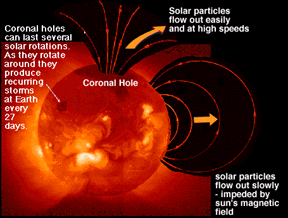 |
After 27 days ....
Coronal holes are eaily seen as dark regions in xray images of the sun such as the one to the left. The unique feature of coronal holes compared to surrounding regions is that magnetic field lines within the coronal hole extend outward into the interplanetary medium. This allows solar wind plasma to freely flow out into interplanetary space. In surrounding regions, the magnetic field lines resemble arches with both feet connected to the solar disk. The outward flow of plasma in this region is impeded by these closed field lines.
Polar coronal holes almost always exist. However, the fast streams that are associated with the polar coronal holes never reach the Earth. During some intervals, coronal holes are formed at lower solar latitudes. In this location, the coronal holes spray the Earth with high speed plasma streams, like a powerful garden sprinkler, and are responsible for generating space weather storms that recur in intervals of 27 days as the coronal hole rotates back over the limb of the Sun. These recurrent storms tend to be weaker than storms produced by coronal mass ejections and to be most frequent during the years just following solar maximum. |





